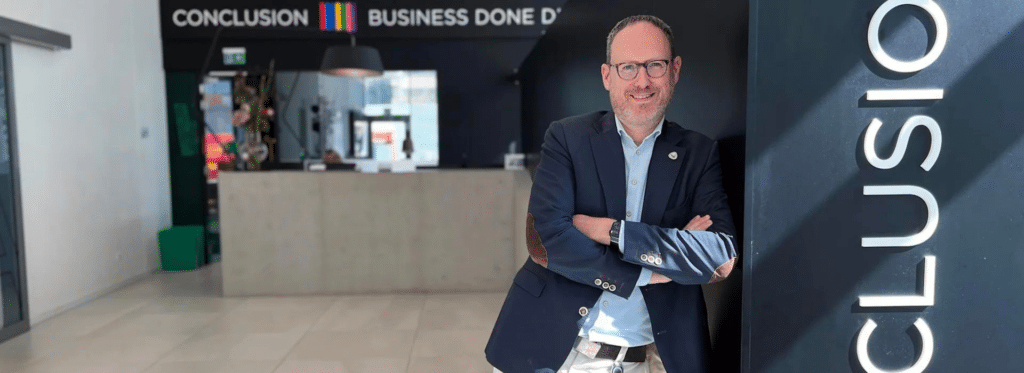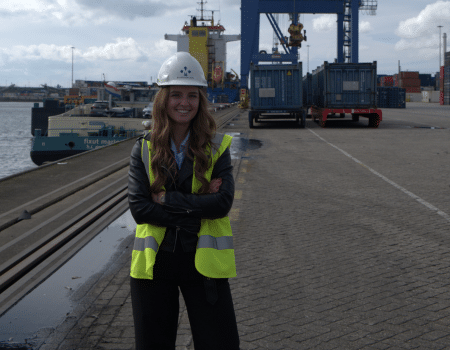Make use of INBISCO QHSE
More than 600 reports per year
ISO9001, 14001, 45001, 50001 certified
At the beginning of this year we were welcome at Solvej Schenk; the HSEQ Manager of Rietlanden Terminals. Solvej shared how she got to know INBISCO, implemented it and used it in the daily operations at the terminal.
In the port of Amsterdam, divided into two locations, Rietlanden has been an important player in the storage and transhipment of various cargo flows for years. Solvej has been working at Rietlanden since 2015 and is responsible for the safety of people and the environment, among other things. She also uses a reporting system for this, namely INBISCO – QHSE.
As a storage and transhipment company, Rietlanden does not have its own products. Most cargo flows come from the parent company. In total, about 100 people work at the terminal. Of the 100, the majority are operational; a ratio of about 70 to 30. After a takeover in 2008, the focus on health and safety continued to grow and that is still the case today, years later. The organisation is therefore proud that the terminal is neat and tidy and that there is a high level of safety awareness. This not only increases safety, but also makes working conditions more pleasant.
“People are used to being treated well. That’s what they deserve, to be able to work safely. ‘Raise your finger for safety’, we say. You have the right to work safely. So if it’s not safe, then you shouldn’t do it.”” People are used to being treated well. That’s what they deserve, to be able to work safely. ‘Raise your finger for safety’, we say. You have the right to work safely. So if it’s not safe, then you shouldn’t do it.”
With the increased focus on safety, reporting anomalies also became increasingly important. The previous system, built by a one-man company, no longer met the needs of the organization.
“The dependency on one person and the desire for compatibility with our systems were the reason we decided at that time that we wanted a different system. In addition, we wanted to see more functionalities in the system.”
Different systems were looked at, but none of them really appealed or exactly matched the requirements. Other objectives took precedence. When the search was on the back burner, Solvej attended a presentation by INBISCO’s managing director Koos. This appealed to me. Solvej was lucky enough to be able to take a look behind the scenes at fellow terminal EMO, which also uses INBISCO. This allowed her to see how they implemented the system. Koos was then invited to give another presentation to the MT. Inspired by the possibilities, Rietlanden decided to choose the system and then went to work himself.
“The system is very easy to use and to set up. I like to come up with a concept from A to Z; Okay then I want this, then I want to be able to do such and such with it, how can I find it again, how can I work with codes or a way that it is just properly linked to each other.”
So how do you use a system optimally? Getting everyone in the organization on board.
“If the MT doesn’t support it and there is no support in the organization, you can forget about it. You can’t pull this on your own. It’s a fantastically beautiful system, but you can buy the most beautiful system in the world, if it’s not worn, it won’t come out.”
“We gave an internal training course when we set it up. The people involved. Said what it can do. How to fill it. I mean, anyone can make a report. You follow the screen and you’ll be fine. But, we do have different types of reports and we ask in advance, guys, see which one is the most appropriate.”
“We do see a difference between the employees who report and those who don’t. The shovel operators or the crane drivers don’t actually work with INBISCO. They are neatly placed in the system. They report things to their foreman and the foreman reports it in the system. But you still want to have them with you. You also want them to be able to see their report and see what steps have been taken.”
INBISCO – QHSE can be set up according to the wishes of an organization. It is therefore also up to you to decide what is or is not included in the system. Solvej explains:
“It’s a bit of cherry picking with the system what I do and don’t use, and what I do and don’t use for. We are working on INBISCO Process Manager. It’s almost finished now. That turned out very nice. Maybe we will do RASCI again, but there are also other things to do. So RASCI is going to put it on hold for now. We also have asset management, but that hasn’t quite become what I want it to be. So we still have to look at that.”
‘You start using and “”abusing”” it for more and more things. That you think, oh I can control that very well in this.”
In this way, the system can also easily grow within the organization. The more information there is in the system, the more important it is to fine-tune the information.
“The importance of coding is also evident from its use. The pulldown menu shows some of the choice fields, but not all. It shows four or five things. So it could have been a bit bigger, but when typing the letters, the choice comes up.”
Solvej uses the system for various areas within the HSEQ policy. This is mainly for registering and following up on deviations, tasks or actions.
”It’s a tool. It registers, you can look back and see what measures you have taken. We want to use the reporting function a bit better, so that we can also analyze more.”
A management system will not save you time when implementing measures, but a well-designed system can help in other areas. It is an accessible system, easy to operate, even for a layman. It’s all pretty self-explanatory.”
”You know what I don’t spend much time on? For example, reports to the Environment Agency. If an unusual occurrence occurs, you must report it to the Government. They want to see what has happened and what is being done about it. The reports are made in the system and then they are followed up. Then I can say, all environmental reports from that date to that date, I export them to Excel and then I send them to the Government. Nice and easy.”
“The reports also indicate whether that report is ISO or Occupational Health and Safety or Environment or Energy related. You can easily navigate through it. Auditors are very happy about that. It’s so easy to show how you can control it. And then they are impressed by how it looks and how easy it is to recall things.”
But what remains the most important thing at Rietlanden Terminals is, of course, safety. “We are very focused on getting people to sound the alarm themselves. That they take responsibility for their own safety and for the safety of their colleagues. It is the demonstrability and manageability that we mainly use the system for.”

Thousands of users use the INBISCO software on a daily basis. Curious about their experiences? Read their stories.

Conclusion is an ecosystem of more than 25 expert companies that together focus on business transformation and IT services.

Matrans Rotterdam Terminal is a multifunctional terminal with a 1.1-km-long deepwater quay, sufficient crane capacity, quay cranes and mobile harbor cranes up to 145 tons.

In the port of Amsterdam, Rietlanden Terminals has been a major player in storage and transshipment for many years.